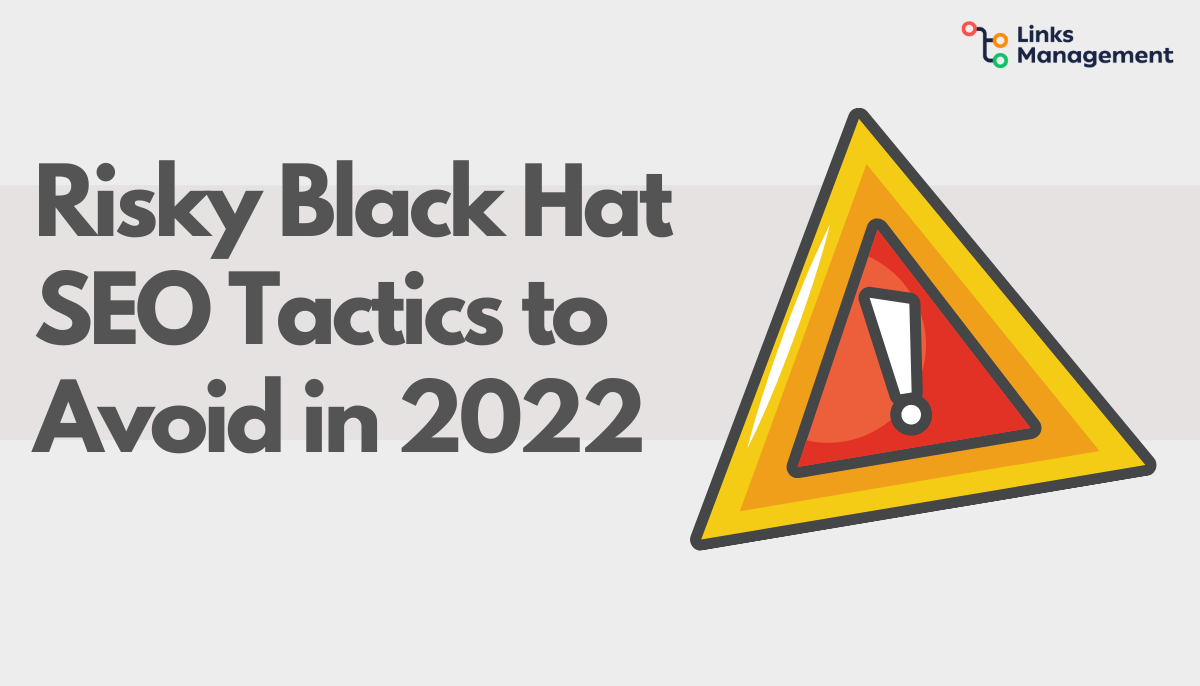Risky Black Hat SEO Tactics to Avoid in 2022
Before we dive into the various Black Hat SEO techniques, let’s first understand what a Black Hat is and why it has gained prominence in the SEO industry.

Black Hat SEO is a collection of unfair practices designed to improve rankings in Google search results. These methods are called Black Hat because they go against the search engine guidelines laid out by Google. Some commonly used Black Hat SEO techniques include keyword stuffing, masking, paid links, doorway pages, hidden content, and duplicate content. Let’s discuss each of them in detail.
9 Most Popular Black Hat SEO strategies
1. An overabundance of key phrases on the page
Keyword stuffing is the insertion of multiple keywords into one sentence. This technique refers to filling the page with keywords in order to rank higher in search results. Repetition and paraphrasing of the same words and sentences help to manipulate search robots and get a higher ranking.
2. Duplicate content
This is one technique where content from one page is simply copied by the site owner to their own site. Stealing other people’s goods is a crime, right? The same goes for content. Google is strictly against this practice and gives pre-reads to the original source of the content.
3. Cloaking
Cloaking is a search engine optimization technique in which the content presented to the search engine spider is different from that presented to the user’s browser.
This practice, seen as a hacking technique, involves showing one version of your site to the Google bot and another version to the user.
This can be achieved in two ways:
- Displaying an HTML text page for search engines, and at the same time displaying a page full of CSS, JS, and content with lots of images to users.
- Embedding text or keywords into a page and displaying that page only when the user agent crawling the page is a search engine and not a user.
4. Doorway” pages
These landing pages are specifically designed for focused queries and are designed to rank for specific keywords. These pages have no value to the user and are used solely to trick the search engine into moving a guest from a search query to another web page, i.e. to an undefined destination. They are filled with content that has a lot of keywords and CTAs. In addition, when the end-user clicks on these pages, they are taken to a different landing page; therefore, these pages are also considered a modified form of redirects.
5. Link Farming Doorway
A link farm (doorway) is a site or a group of sites that are created solely for creating links and promoting another project. Each site in such a link farm points to a specific site that should rank higher on the search engine result pages. Search engine crawlers rank a site based on the number of sites it links to. In Black Hat SEO techniques, this is used to increase the number of backlinks that a particular site receives from such link farms.
6. Invisible text or links
This technique involves placing white text on a white background. The principle is to blend the text color with the background color. In this way, website owners hide their keywords from users but make them visible to the Google bot. A similar practice is carried out for links.

7. Spam in blog comments
This is a strategy that involves adding comments on blog pages along with a link to the site. This is solely in order to get a link back from this site. Search engines now ignore such links from blog comments. Commenting on blogs with links to your site is a spamming way of getting it and we strongly recommend that you avoid this practice. Search engines will completely remove spam pages from search results.
8. Invalid redirection
Redirection is a great technique to redirect the user to a properly functioning page if there is a problem with the current page. Site owners often use 301 redirects in such cases.
However, black-hat “experts” use such redirects to take users to another page. Thus, they trick both the Google bot and users by showing them a page with an invalid URL that they did not intend to visit.
9. Overly Optimized Pages
You know the saying: too much of something is bad for you? The same is true for your pages. Sometimes SEO professionals are so busy trying to optimize their pages that they end up doing it unnecessarily much. This includes the use of many elements on the page, such as over-optimized anchor text, large numbers of internal links, content, headings, and keyword-rich descriptions.

Why You Should Avoid Black Hat SEO
While Black Hat SEO is not illegal, it violates the webmaster guidelines set by search engines. In other words, it’s still against the rules. This means that if you are doing SEO in a Black Hat, you should be prepared to receive a nasty fine as punishment.
Receiving a fine from search engines will cause your site to drop in search results, or worse, it can be completely removed. This means your site will receive less traffic and, ultimately, fewer customers.
Appearance in search results is vital to business growth, but there is a right and wrong way to do search engine optimization. Black Hat SEO practices are the wrong way to go. Black Hat SEO seeks to manipulate search algorithms, not solve user problems.
Keep in mind those simple truths and you will not make mistakes with your SEO:
The first tool that no longer works in SEO: poor quality links
In SEO, quality is more important than quantity. The same principle applies to link buying. If you are faced with a choice: buy 10 cheap links from some unknown resource or buy 1 link, but from a good thematic site within your area, follow the second scenario and buy one link. This is because a large number of links from inappropriate resources will give you less return than one high-quality link.
The second tool that no longer works in SEO: keyword spam
What does over-spam mean? If you are still writing on your site something like this: “Buy windows Atlanta cheap with the installation” – then we have bad news for you. Probably, your site is over spammed with keywords and you are losing a significant amount of traffic and customers
The third tool that no longer works in SEO: junk content that is written just to get traffic
This point flows smoothly from the previous one. Once, it was popular to write articles and collect pages on sites, which consisted of a large set of keywords and a very small amount of information useful to the site visitor. Thus, it turned out that people who visited the site did not receive answers to their questions and went to look for answers further. Search engines saw this trend and announced that now the advantages in search results will be given to those resources that respond to the client’s request and know how to keep visitors’ attention.
We’ve looked at tools that don’t work.
Now let’s talk about something that continues to work and bring traffic and customers.
The first tool that works in SEO: a systematic approach to promotion
A systematic approach is probably the basis for success. If you consistently write 1-2 articles per week for 10 years, then this will give you a huge base of readers and clients.
The second tool that works in SEO: mobile optimization
The share of mobile traffic is growing more and more every year. Already, more than half of our site visitors view it from mobile devices. Whereas a couple of years ago, these indicators were about 20-30 percent of the total. Therefore, we recommend that you check out how your website pages look from various mobile devices and tablets right now. Search engines are very fond of resources that think about their visitors and optimize their content for their convenience.
The third tool that works in SEO: continuous analytics
Analytics is your compass in the “dark forest” of business, and when you don’t understand where to go, you can always count the numbers and draw up the right promotion strategy.
What indicators need to be recorded in SEO analytics:
- the number of site visitors from search;
- viewing depth (i.e., how many pages visitors of your site view in one session;
- the average time spent on your site;
- average position of your site in search results;
- bounce rate.
The fourth tool that works in SEO: organic growth of behavioral characteristics
This point flows smoothly from the previous one. By tracking analytics and understanding your metrics, you can influence them. For example, you can see that in one session, your visitors view an average of 1.2 pages of your site.
Knowing this indicator – you can put forward hypotheses and change your strategy. For example, you can start adding links inside your pages to other useful articles/research from your site that your reader will find useful. This tool is called “linking” and allows you to increase one of the key metrics of audience engagement: viewing depth.
The fifth tool that works in SEO: Useful Content Written to Solve People’s Problems
A key SEO rule to understand and remember is that your content should be of value to your customers. All of your marketing should be geared towards satisfying and delivering customer value.
In contrast to Black Hat strategies, these are the key principle that works and will always work.
Enter URL & See What We Can Do Submit the form to get a detailed report, based on the comprehensive seo analysis.